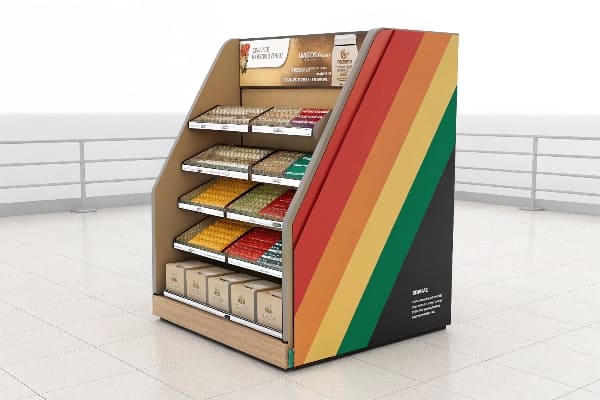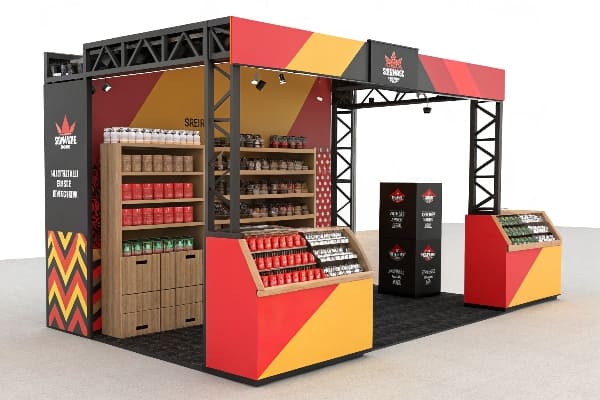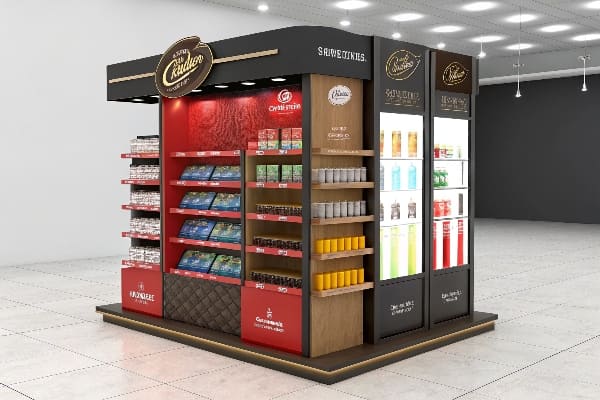Every shopper walks past in seconds. If my display does not hook them, the sale is lost. I want simple moves that make people pause, reach, and buy.
Effective CPG displays grab attention instantly, show one strong benefit, use eye-level placement and bold color, carry the right stock, and invite touch—turning quick glances into measurable sales lifts.

A few smart rules and repeatable steps keep a display working day after day. Let me walk you through the questions I hear most and the methods I use on every project.
How do you create an effective display?
Shoppers skip what feels confusing. When my message is blurred, I lose them. I must solve that pain by turning clutter into clarity and giving every element a clear job.
I create an effective display by defining one promise, shaping sight lines around it, using color blocks, keeping stock full, and checking results daily.

Break the goal into five focus areas
I start with the outcome: more units sold per square foot. To reach it, I map five focus areas:
| Focus Area | Why It Matters | Quick Check |
|---|---|---|
| One-sentence promise1 | Stops scroll-by shoppers | Can I read it in two seconds? |
| Vertical sight line | Guides eyes to product | Tall header above eye level |
| Color contrast | Drives recognition | Brand palette vs. neutral store shelf |
| Stock depth2 | Signals popularity | Front row always full |
| KPI tracking3 | Shows what works | Daily unit sales vs. control |
1. Lock the promise
I write one line that joins product benefit with shopper need, like “Hydrate faster on busy days.” It goes on the header—bold, short, large.
2. Set the sight line
I keep the sign at 60-65 inches from the floor, then slope products down to hand level. Shoppers follow the line straight to the grab point.
3. Use color blocks
I pick two brand colors and one neutral. Large blocks keep the look calm. I avoid rainbow noise that dilutes focus.
4. Guard stock depth
I tell staff “face up” every hour. A half-empty row whispers “leftovers.” A full row shouts “hot seller.”
5. Track and tweak
I record daily units. If lift stalls, I swap copy or adjust height. At Popdisplay’s factory I build quick mock-ups in corrugate, test in a local store, then mass-produce only after numbers confirm a win. The loop is simple yet strict, and it keeps waste low for both me and clients like Barnett Outdoors.
What are the 5 steps of creating a display?
Many teams jump straight to artwork. They hit delays, run over budget, and miss launch day. The fix is a clear, five-step path that I never skip.
The five steps are brief: define goal, draft concept, prototype, test in store, and roll into mass production.

A disciplined pipeline cuts time and cost
Each step feeds the next. I keep them short but strict:
| Step | Deliverable | Time Box | Key Tool |
|---|---|---|---|
| 1 Goal | Written KPI: units/week4 | 1 day | Kick-off call |
| 2 Concept | Sketch + copy | 2 days | Miro board |
| 3 Prototype | Full-size corrugate sample | 5 days | Popdisplay CAD cutter |
| 4 Test | Sales vs. control shelf | 14 days | POS data pull5 |
| 5 Production | Final print files + pallet plan | 7 days | Auto die-cut press6 |
Goal
I choose one number: extra units per week. Everyone lines up behind it.
Concept
I sketch by hand first. Short copy, clear color, hero product centered. My industrial designer turns it into 3D.
Prototype
At our Guangzhou plant we cut and print a live corrugate piece. If Barnett’s engineers spot weak corners, we tweak flute or add inner braces.
Test
I place two prototypes in a mid-volume store. POS tells me truth. If lift beats 20 %, we lock.
Production
We run the die-cut press, mount offset sheets, pack flat. A single pallet holds 250 displays, ready for U.S. freight.
Staying strict on timing protects launch windows and slashes last-minute air freight costs.
How to make standout product displays?
Stores are loud. A display must yell without looking desperate. I look for standout effects that still feel on-brand and premium.
Standout displays focus on one hero product, exaggerate shape or motion, add lighting or texture, and let shoppers interact.

Four levers build a “wow” effect
I use a simple checklist—Shape, Light, Texture, Play—to judge ideas:
| Lever | Example | Benefit | Risk |
|---|---|---|---|
| Shape | Arrow tower for energy drinks | Points to shelf | Over-engineer, higher cost |
| Light | Edge-lit header | Glows in low aisles | Needs wiring approval |
| Texture | Soft-touch lamination on beauty box7 | Signals premium | Fingerprints |
| Play | Pull-tab tester for crossbow string | Hands-on trial | Reset needed |
Shape
I push corrugate beyond rectangles: wings, curves, even a free-standing bolt form for Barnett. CNC scoring keeps folds crisp8.
Light
Battery LEDs in the header catch eye in seasonal aisles. I place the battery door where staff can reach.
Texture
Soft-touch film on high-end grooming kits makes shoppers rub the pack. For CPG sachets I emboss a droplet shape to tie to hydration claims.
Play
Interactive demos boost dwell time9. I added a rubber string tensioner on a crossbow display. Shoppers pulled, felt resistance, and sales jumped 32 %.
Pulling one lever is good. Two levers together create a moment Instagram loves, without blowing budget.
What is the key to making a merchandise display visually appealing?
Even a bold concept fails if elements fight each other. Visual appeal rests on harmony. I chase a balance of space, color, and hierarchy.
The key is visual hierarchy: one focal point, clear groups, enough blank space, and a color scheme that guides the eye smoothly.

Build hierarchy with three layers
I break every design into headline, product block, and supportive detail:
| Layer | Content | Size Rule | Placement |
|---|---|---|---|
| 1 Headline | Benefit phrase10 | Largest | 60–65″ high |
| 2 Product | Core SKUs11 | Medium | 36–60″ |
| 3 Detail | Price, QR, story | Small | 24–36″ |
Headline
I write it like a billboard: five words, active verb, shopper benefit. Large sans-serif, high contrast.
Product block
I group SKUs by color to avoid visual noise. I leave two inches of air between packs. That negative space beats bold pattern clutter every time.
Detail
I keep QR codes12 and bullet points low. Shoppers who bend to read are already interested. This keeps top areas clean for new viewers.
I pull back on decoration. Simple beats busy. Using Popdisplay’s digital proof, I toggle layers off until the message snaps into focus. When each level does its job, the whole display looks calm yet strong.
What makes a display attractive?
Attractive means it feels right at first glance. It needs to mix beauty with trust, and turn standing space into an invitation.
A display feels attractive when it balances clean design, brand consistency, and emotional cues that mirror the shopper’s own goals.

Mix function with emotion
An attractive display tells a small story that matches the shopper’s day. I follow this model:
| Element | Functional Check | Emotional Check | Result |
|---|---|---|---|
| Color | Brand palette | Mood tone | Fast recognition |
| Typography | Read in 2 s | Friendly voice | Approachability |
| Imagery13 | Shows product in use | Mirrors target’s life | Believability |
| Structure | Stable, tidy | Fits personal space | Comfort |
| Call-to-action14 | Clear, short | Inspiring verb | Urgency |
Color and typography15
I keep fonts no smaller than 18 pt on key claims. I choose one accent color only. Too many colors cause mental drag.
Imagery
I photograph products in real settings. For a hydration drink I shoot morning commute. For a crossbow I show forest dusk. Shoppers see themselves and lean closer.
Structure
Hidden braces stop wobble. A shaky stand screams cheap. I run drop tests in our plant and share the clip with buyers to build trust.
Call-to-action
I pick active verbs: “Grab,” “Test,” “Fuel.” One word. Big font. Bottom right.
When function holds firm and emotion rings true, the display earns a double take. That moment is worth every prototype.
Conclusion
Great displays are simple: one promise, tidy space, bold design, and strict process. Follow these steps, test fast, and watch units climb.
Learning about the one-sentence promise can enhance your marketing effectiveness and customer engagement. ↩
Exploring stock depth can reveal its impact on customer perception and sales performance. ↩
Understanding KPI tracking can help you measure success and optimize sales strategies effectively. ↩
Understanding how to set effective KPIs can enhance your project management skills and ensure successful outcomes. ↩
Exploring POS data analysis can provide insights into consumer behavior and help optimize sales strategies. ↩
Learning about auto die-cut presses can improve your production efficiency and reduce costs in manufacturing. ↩
Explore how soft-touch lamination enhances product appeal and communicates quality, making it a must for premium packaging. ↩
Discover the advantages of CNC scoring in creating precise and innovative packaging designs that stand out on shelves. ↩
Learn how interactive demos can significantly enhance customer experience and drive sales in retail environments. ↩
Understanding the role of a benefit phrase can enhance your design strategy, making it more effective in capturing shopper attention. ↩
Learn how to group core SKUs to minimize visual noise and improve shopper experience in your displays. ↩
Explore best practices for QR codes to engage shoppers effectively and enhance their shopping experience. ↩
Discover how effective imagery can create relatable scenarios that draw shoppers in and increase engagement. ↩
Learn about powerful call-to-action techniques that can inspire immediate shopper responses and boost sales. ↩
Explore this link to understand how color and typography can enhance product visibility and emotional connection with shoppers. ↩

